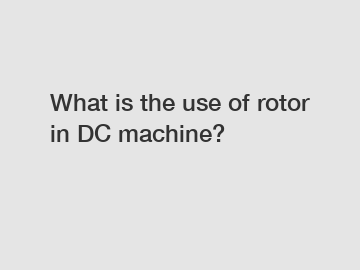What is the use of rotor in DC machine?
What is the use of rotor in DC machine?
The use of a rotor in a DC machine is an essential aspect of its functioning. As the name suggests, the rotor is a rotating component that plays a crucial role in the conversion of electrical energy into mechanical energy. It is a central element in the direct current (DC) generator or motor, enabling the machine to produce power or perform mechanical work. Let's dive deeper into the importance and functions of the rotor in a DC machine:
1. Magnetic Field Generation:

The rotor in a DC machine is responsible for creating a magnetic field. By utilizing the principle of electromagnetic induction, the rotor generates a magnetic field when current is passed through its windings. This magnetic field interacts with the stator, which is the stationary part of the machine, resulting in the conversion of electrical energy into mechanical energy in motors or vice versa in generators.
2. Commutation:
Commutation is a vital process in a DC machine that ensures the continuous flow of electricity and maintains the direction of current. The rotor's construction, typically consisting of multiple conductive segments, aids in this process. As the rotor spins, it interacts with the stator's stationary brushes, which are in contact with the segmented commutator. The brushes and commutator work together to switch the current direction as the rotor rotates, allowing for the consistent delivery of power or the generation of electrical energy.
3. Conduction of Current:
The rotor in a DC machine facilitates the conduction of current. Through the commutator and brushes, it provides a path for the electrical current to flow into the rotor windings. These windings are typically made of copper or other conductive materials, ensuring efficient conduction of current during operation. The path established by the rotor allows for the conversion of electrical energy into mechanical energy, enabling the machine to perform work.
4. Amplification of Torque:
The rotor also contributes to the generation of torque, which is essential for the rotational motion of the machine. Torque refers to the twisting force that results in the spinning of the rotor or the shaft connected to it. The rotor's magnetic field interacts with the stator's magnetic field, creating a rotational force. This force is then transferred to the shaft, allowing it to perform the work required in various applications. The rotor's design, materials used, and the number of windings impact the amount of torque generated in the machine.
In conclusion, the rotor's significance in a DC machine cannot be overstated. It acts as the primary component responsible for magnetic field generation, commutation, conduction of current, and torque amplification. Without a properly functioning rotor, the DC machine would be unable to convert electrical energy into mechanical energy efficiently. By understanding the various aspects of the rotor's use, we gain insight into the fundamental principles behind the operation of DC machines.
For more information, please visit stator and rotor core, welded lamination cores, dc motors stator and rotor components.


